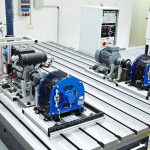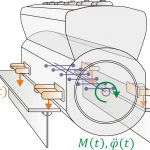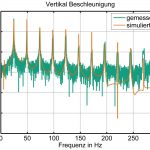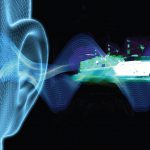In early design stages, efficient analysis methods for predicting the vibro-acoustic behavior of vessels are of central importance. A prediction tool can help to identify critical points and to avoid costly rework subsequent to sea trials.
Owners and shipyards define low limits for noise and vibration that must be met during operation of the ship. On[ds_preview] the other hand, lightweight construction in combination with a considerable number of excitation sources on board lead to vibrations with negative effects on safety and comfort.
An approach based on numerical system-level simulation is proposed to estimate noise, vibration and harshness performance during each step of the design process. A consortium with partners from industry, research institutes and universities, including the Fraunhofer Institute for Structural Durability and System Reliability LBF has developed a prediction software tool within the research project EPES »Efficient prediction of vibro-acoustic properties in the ship design stage« funded by the Federal Ministry for Economic Affairs and Energy.
Comfort more important
Comfort on board has become increasingly important as a quality criterion for ship passengers in recent years. Owners and shipyards follow that trend and define low limits for noise and vibration that ships must comply with during operation. The acceptable noise levels on board ships specified in the new resolution Code on Noise Levels on Board Ships by the International Maritime Organization (IMO) are legally obligatory since July 2014. For example, in ship cabins a sound level only to a limit of 55 dB (A) is defined as acceptable. An efficient prediction of the vibro-acoustic behavior of vessels helps to identify weak points in the construction or to optimize the ship design and avoid costly rework subsequent to sea trials.
Shipyards are generally not able to refine their construction plans based on physical prototypes as their product is manufactured only once or in very small and limited numbers. In addition, the product development cycles are relatively short. By considering numerous sources of air-borne and structure-borne noise on board as well as the mechanical behavior of the vessel, efficient numerical prediction is needed to improve the construction and design process. The methods applied to calculate the vibro-acoustic properties of ship designs are quite accurate nowadays, but often computationally inefficient or the results can only be gained late in the construction process.
Acoustic optimized ship design
The researcher at Fraunhofer LBF focused on the development of numerical models of main excitation sources on board within the project EPES. Parametric excitation models for main engines and pumps as well as structural models for power trains and foundations were built up. The sources introduce excitation forces into the foundations or torsional moments into the power train. The resulting torsional vibrations again induce structure-borne noise into the gear box, clutch and other parts of the power train.
The developed models are described using a finite number of parameters and can be initialized very easily. This can be important in a pre-contractual phase of the ship design, where only a few latter built-in components are defined. Using parametric models can help to evaluate varying installation circumstances or varying components in order to optimize the ship design. The overall simulation model is built up modular and contains structural submodels as well as excitation submodels. The mechanical structure of the excitation sources are modeled as rigid bodies with six degrees of freedom and their inertia properties are determined experimentally. The structural model of the power train is set up as coupled torsional oscillators. The parameters of the excitation forces and accelerations are measured on test stands or result from the description of physical effects like the combustion process, where both gas and inertia forces occur and excite vibrations in the mechanical structures. All acting forces are calculated and summed considering their phase relationships or ignition sequences.
Various excitation sources that cause periodic vibration phenomena, i. e. engines and ancillary machinery can be simulated using such parametric models. During the Project numerical models of a propulsion main engine and a cooling water pump were built up and a torsional vibration test stand was used to verify the proposed simulation approach. The test stand consists of an internal combustion engine, a rotor and an eddy current brake. With the focus on validating the numerical excitation models, various comparative measurements as well as system-level simulations using Matlab/Simulink were performed. Both stationary operational conditions and transient excitations, e. g. engine run-ups and misfiring, can be simulated.
Toolbox available
The researchers finally evaluated the accuracy of the model by comparing numerical and experimental test data. The results show that the proposed methods can be used to predict the excitation forces and accelerations introduced into the foundations. The proposed numerical model is a part of a software toolbox to predict the vibro-acoustic behavior of a vessel efficiently. One of the aims of this toolbox is the identification of acoustic excitation mechanisms in an early phase of design and also in parallel to the development process.
The modular and hierarchic modeling scheme enables the user to easily replace submodels to assess the impact of noise and vibration reduction measures. A prototypical implementation of these newly developed methods is currently provided to the shipyards. Furthermore, the research and development activities at Fraunhofer LBF continue so that the methodologies can be transferred and applied on tasks in the automotive, aviation or any other engineering industry.
Holistic simulation approach
For Fraunhofer LBF the results gained in the project EPES have been further steps towards a holistic approach for the analysis and evaluation of mechanical systems. Experimental and numerical analyses as well as noise and vibration control measures are offered by the institute as vibro-acoustic engineering services. Often the system analysis starts with experimental structural dynamics methods in field trials or in the laboratory under defined environmental conditions. In addition holistic approaches for the numerical modeling, simulation, analysis and optimization of passive and active structures are provided. At Fraunhofer LBF passive, semi-active or active systems for noise and vibration reduction are developed using these techniques. An improvement of the vibro-acoustic behavior of an investigated mechanical structure is evaluated by verification experiments.
Besides Fraunhofer LBF the project consortium in EPES consists of the institute System Reliability and Machine Acoustics SzM (Technischen Universität Darmstadt), Flensburger Schiffbau-Gesellschaft mbH & Co. KG, Fr. Lürssen Werft GmbH & Co., Novicos GmbH, Technische Universität Berlin, Technische Universität Hamburg-Harburg, Howaldtswerke-Deutsche-Werft GmbH and TKMS Blohm + Voss Nordseewerke GmbH.
Dipl.-Ing. Christoph Tamm

























